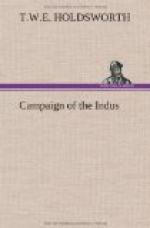Patala (Tatta), where he built a citadel and formed
a port for his shipping. He then proceeded, with
part of his fleet, by the western branch of the river,
to discover the ocean. This he accomplished at
great hazard, when he sacrificed to the gods (particularly
to Neptune), and besought them not to suffer any mortal
after him to exceed the bounds of his expedition.
He then returned to join the rest of his fleet and
army at Patala, and to make arrangements for his march
to Babylon. He appointed Nearchus admiral of
his fleet, and having given him orders to ascend the
Persian Gulf to the Euphrates, he commenced his march
through Beloochistan, leaving Nearchus to follow him
as soon as the season would permit. Alexander
was more than sixty days in reaching the frontiers
of Persia, during which time his army sufficed such
dreadful privations from want of food, that the soldiers
were obliged to eat their own war-horses, and from
the sickness consequent upon such a state of distress,
his army was reduced to less than one-half of the
number which left Patala. It is not necessary
to follow him to Babylon, or to describe the voyage
of Nearchus, who, having sailed up the Persian Gulf,
united his forces to those of his royal master in
the river Pasi-Tigris, near Susa. Enough, however,
may be learned from this history to convince us that
if such an army could be conducted 2000 years ago
from the Hellespont to the Jaxartes and Indus, the
march from the southern shores of the Caspian Sea to
Cabool would require comparatively but very slight
exertion, if those who have the means should have
the desire also to accomplish it.
I can say little of my own knowledge of the political
causes which gave rise to the war, as I am unacquainted
with the affairs of India and the motives which actuated
its governors; but a brief outline may be collected
from a book lately published by the Hon. Capt.
Osborne, military secretary to the Governor-General,
to which I shall refer, after making some observations
upon the countries through which the operations of
the army were conducted, and particularly on the situation
of Afghanistan, in reference to those persons who had
before been, is well as those who were, its rulers,
when Shah Shooja was restored by the British Government
to its throne. These observations I have chiefly
collected from the valuable work of that enterprising
officer Lieut. Burnes, which he published after
visiting those countries in 1831, 1832, and 1833.
The chief portion of the Bombay division of the army
engaged in the operations to which these letters refer,
landed at the Hujamree mouth of the Indus, and marching
through Lower Sinde, by Tatta, ascended the Indus
by its western bank. On arriving in Upper Sinde,
it was found that Shah Shooja with his contingent,
as well as the Bengal division of the army, had crossed
the Indus en route from that Presidency, and
had advanced towards Afghanistan, and that the Bombay
division was to follow them. To effect this,




